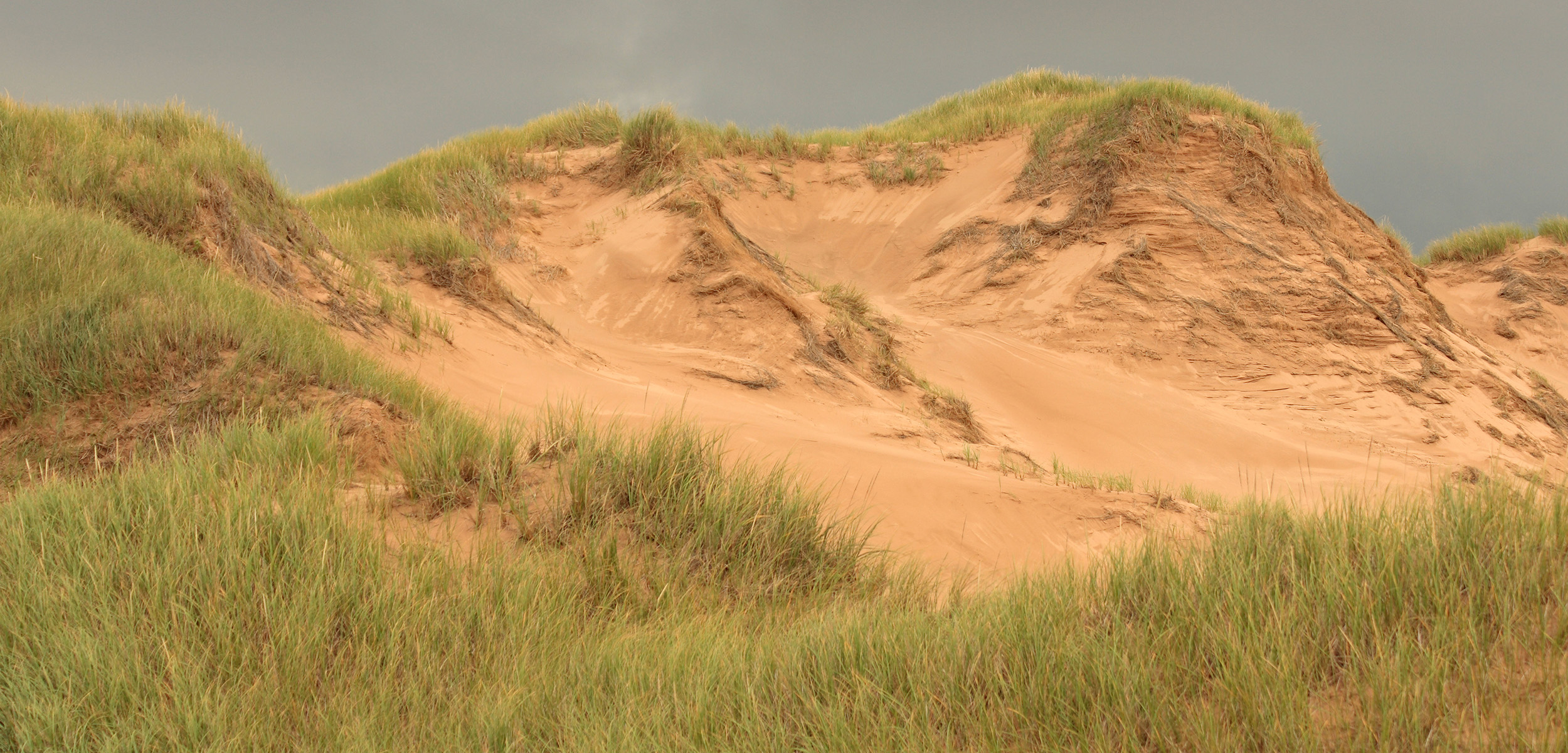Sand Dunes vs. Super Storms
One year after Hurricane Fiona walloped Prince Edward Island, scientists consider what damage and recovery might mean for sand dunes facing powerful future storms.
Article body copy
Two weeks after Hurricane Fiona made landfall in Atlantic Canada on September 24, 2022, Jeff Ollerhead found himself staring at an upended boardwalk in Prince Edward Island National Park. Damaged by the storm—one of the strongest cyclones ever recorded in Canada—Greenwich Beach was still closed to the general public. Ollerhead, who is a coastal geomorphologist at Mount Allison University in New Brunswick, tread carefully around the doomed boardwalk and a large pond to reach the sand dunes bordering the sea. “The whole thing had been scarped,” he says, referring to how waves had carried away large amounts of sand from the seaward side, leaving the normally sloping face of the dune almost vertical.
The damage Ollerhead witnessed last fall was dramatic but not unexpected. The scientist, who had monitored the Greenwich Dunes for two decades until 2015, knows that the dunes have faced similar devastation in the past. “Greenwich was completely wiped out by a period of storms 100 years ago and regenerated over decades,” he says.
As climate change fuels more frequent and powerful storms, scientists are trying to determine what happens when dunes have less time to recover.
Dunes are formed when waves deposit sand on a beach and winds shape it into mounds. Greenwich Beach has a roughly seven-kilometer stretch of dunes, with vegetation on top that holds the sand in place. During storms, rows of dunes act as barriers, protecting everything inland. Even Hurricane Fiona’s high waves didn’t top the crest of the Greenwich Dunes—though if the storm had hit during high tide, they might have. The waves eroded the dunes, but the sand kept the storm surge from flooding in.
“Sand dunes are built to withstand storms,” says Hailey Paynter, an ecologist with Parks Canada, the federal agency that manages the national park. “They simply need time and space to regrow.”
Fortunately, in the 12 months since Hurricane Fiona, the Greenwich Dunes have shown signs of recovery. Plants are popping up on the ridges closest to the ocean. Over the next few years, the dunes will slowly grow as blowing sand collects around the vegetation.
How quickly dunes recover depends on the amount of sand available to feed them. This isn’t an issue on Greenwich Beach, where sand is abundant, but it can present challenges in other areas. “You need a relatively wide beach and dry sand,” says Danika van Proosdij, a coastal geomorphologist at Saint Mary’s University in Nova Scotia. Dunes on narrower beaches or beaches that are often submerged by the tide will take longer to rebuild.
Over time, winds naturally shift the position of sand dunes and, van Proosdij says, major storms can gradually move dunes inland by pushing sand from the ocean-facing side over the top like a conveyer belt. Repeated erosion from bigger and more frequent hurricanes could transport so much sand that dunes end up re-forming in new places.
But if we want dunes to protect important areas, such as neighborhoods, there may be a point where people need to intervene to keep the sand in place, van Proosdij says. In some places, people are already shoring up vulnerable dunes by trucking in beach sand, reinforcing the mounds with trees, logs, and other biodegradable materials that slow down the movement of sand, or planting vegetation on top.
Ollerhead points out that natural recovery may be slow, but nature can engineer dunes better than people. “You can’t beat nature,” he says. “You have to learn to work with it.” The public can do their part by leaving dunes alone. Despite the resilience of dunes during storms, they’re fragile: marram grass, one of the most important plants that stabilizes the dunes, can be fatally trampled by as few as 10 footsteps. In Prince Edward Island, Parks Canada has blocked off particularly delicate areas with rope and added signage to educate visitors. “We want dunes to be as resilient as possible before a storm hits,” Paynter says.
Fortunately, the Greenwich Dunes have plenty of space to shift and regrow with storms because the surrounding area is protected from development by the national park. Outside the park boundaries, Prince Edward Island recently paused all coastal development while the province develops a long-term policy to protect shoreline ecosystems from the impacts of climate change.
It’s impossible to predict how long it might take the Greenwich Dunes to reach their former size, Ollerhead says. But even as more severe hurricanes hammer Atlantic Canada, the forecast for dunes is generally good—as long as people take care of them. “Most of the dunes will be fine,” he says. “We just have to manage them in a way that allows them to respond to nature.”

